


xxxxxAs we have seen (1828 G4), the English naval
officer and explorer James Clark Ross, who had accompanied William
Parry on his Arctic voyages, joined his uncle John Ross in 1829 in
search of a Northwest Passage. The expedition almost ended in
disaster, but during their stay in the Arctic he discovered King
William Island and Boothia Peninsula, and in June 1831 reached the location of the
north magnetic pole. In 1839 he led his own expedition, this time to
Antarctica, first sighted, as we have seen (1828
G4), by the Russian explorer
Bellingshausen. There he discovered areas now named after him -
JAMES CLARK ROSS 1800 -
(G3b, G3c, G4, W4, Va, Vb)
Acknowledgements
Ross: detail, by
the British portrait painter John Robert Wildman (active 1823-
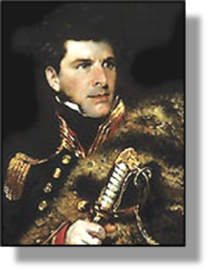 xxxxxThe English
naval officer and explorer James Clark Ross (illustrated) accompanied William Parry on his Arctic voyages in
1819 and 1827. Then two years later he joined his uncle,
John Ross, on an expedition to find the Northwest Passage. It
almost ended in disaster, but, travelling by sledge, he reached the
location of the north magnetic pole in June 1831.
At the same time he discovered King William Island, naming it in
honour of William IV, and the Boothia Peninsula, naming it after the
man financing the expedition, the gin merchant Felix Booth. Little
was achieved after that. The expedition’s boat Victory
having been crushed in the ice, the party was marooned on
Boothia Peninsula, and
was lucky to be rescued by a whaler in the summer of 1833.
xxxxxThe English
naval officer and explorer James Clark Ross (illustrated) accompanied William Parry on his Arctic voyages in
1819 and 1827. Then two years later he joined his uncle,
John Ross, on an expedition to find the Northwest Passage. It
almost ended in disaster, but, travelling by sledge, he reached the
location of the north magnetic pole in June 1831.
At the same time he discovered King William Island, naming it in
honour of William IV, and the Boothia Peninsula, naming it after the
man financing the expedition, the gin merchant Felix Booth. Little
was achieved after that. The expedition’s boat Victory
having been crushed in the ice, the party was marooned on
Boothia Peninsula, and
was lucky to be rescued by a whaler in the summer of 1833.
xxxxxIn 1839 Ross led his
own expedition, this time to the Antarctic -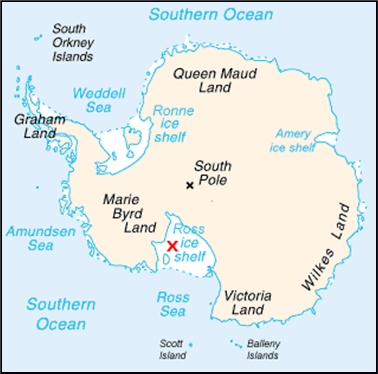 the
Ross Sea and the Victoria Barrier, explored the coast of Victoria
Land and named the two volcanoes Mount Erebus and Mount Terror in
1841. Then, after wintering at Hobart in Tasmania, he chartered part
of the coastline of Graham Land and sailed around the icebound
Weddell Sea. On his return to England in 1843 he was knighted, and
four years later published his A Voyage of
Discovery and Research in the Southern and Antarctic Regions.
Ross Island, Ross Sea, and the Ross Dependency are named after him.
the
Ross Sea and the Victoria Barrier, explored the coast of Victoria
Land and named the two volcanoes Mount Erebus and Mount Terror in
1841. Then, after wintering at Hobart in Tasmania, he chartered part
of the coastline of Graham Land and sailed around the icebound
Weddell Sea. On his return to England in 1843 he was knighted, and
four years later published his A Voyage of
Discovery and Research in the Southern and Antarctic Regions.
Ross Island, Ross Sea, and the Ross Dependency are named after him.
xxxxxRoss began his naval career at the age of nine, serving under his uncle during an unsuccessful expedition to find the Northwest Passage in 1818. He was promoted to captain in 1834 and before setting out on his voyage to the Antarctic, worked for three years, 1835 to 1838, on the magnetic survey of Great Britain. Following the publication of the account of his voyages, he was elected to the Royal Society in 1848. In that year, as captain of HMS Enterprise, he went in search of the explorer Sir John Franklin, lost in the Arctic, as we shall see, in 1845 (Va). He found no trace of Franklin’s expedition, but its dramatic failure renewed interest in Arctic exploration.
xxxxxIncidentally, James Clark Ross discovered the north magnetic pole in 1831, but it was not until 1909, in fact, that the American Robert E. Peary became the first explorer to reach the geographic North Pole. ……
xxxxx…… The massive white barrier wall which was first seen by James Clark Ross in 1841 stretches for about 500 miles from Ross Island in the west to Edward VII peninsula in the east, and rises to about 200 feet in places. It was originally called the Victoria Barrier, but is now known as the Ross Ice Shelf and is shown on the map as such (x) ……
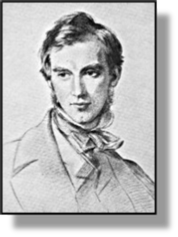 xxxxx…… Onxhis
voyage to Antarctica Ross was accompanied by the English botanist Joseph Dalton Hooker (1817-
xxxxx…… Onxhis
voyage to Antarctica Ross was accompanied by the English botanist Joseph Dalton Hooker (1817-
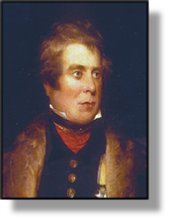 xxxxxFor Ross’ uncle, John Ross (1777-
xxxxxFor Ross’ uncle, John Ross (1777-
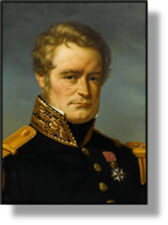
xxxxxDuring the late 1830s, at
the beginning of the Victorian era, two further expeditions were
made to the Antarctic. The French navigator Jules
Dumont d’Urville (1790-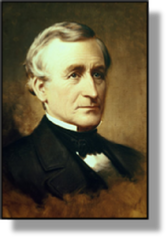 tragically
killed in a railway accident in France.
tragically
killed in a railway accident in France.
xxxxxThen in 1838 to 1842 the
U.S. naval officer Charles Wilkes (1798-
Including:
John Ross (Arctic),
Jules Dumont d’Urville and
Charles Wilkes (Antarctic),
and The Falkland Islands

W4-
xxxxxIt was at
this time, in 1833, that the British occupied The
Falklands a group of islands in the
South Atlantic some 300 miles off the coast of Argentina. Thought
to have been discovered by the English navigator John Davis in
1592, the islands were named after Lord Falkland at the end of the
17th century. However, the French and Spanish arrived in the area
and by 1774 the English had been ejected. In 1820, having
overthrown the Spanish, the Argentines claimed the islands as the
Malvinas, but the British seized them in 1833 and began a
permanent settlement. However, the dispute over sovereignty
continued. Eventually the United Nations took up the matter in
1964, but in April 1982 Argentina seized the islands from the
British. In the ensuing war Britain regained its colony by mid-
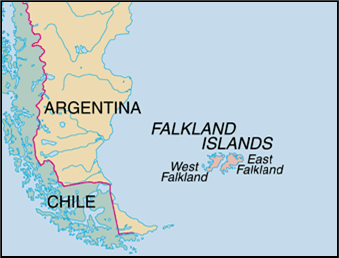 xxxxxIt was at this time, in 1833, that the British occupied
The Falklands, a small group of
scattered islands in the South Atlantic some 300 miles off the coast
of Argentina. Thought to have been discovered by the English
navigator John Davis in 1592, they were named after Lord Falkland,
treasurer of the English navy, at the end of the 17th century.
English settlers arrived in 1765, but by that time the French and
the Spanish had arrived in the area. In 1770 the Spanish bought out
the French, and by 1774 had ejected the English. With the collapse
of Spanish colonial rule, the Argentines overthrew the Spanish in
1816 and, four years later, claimed sovereignty over their “Islas
Malvinas”. The British, however, still laying claim to the
territory, took over the islands in 1833, meeting no resistance, and
established a permanent settlement, centred around Port Stanley on
the larger of the two main islands. Colonial status was granted in
1892.
xxxxxIt was at this time, in 1833, that the British occupied
The Falklands, a small group of
scattered islands in the South Atlantic some 300 miles off the coast
of Argentina. Thought to have been discovered by the English
navigator John Davis in 1592, they were named after Lord Falkland,
treasurer of the English navy, at the end of the 17th century.
English settlers arrived in 1765, but by that time the French and
the Spanish had arrived in the area. In 1770 the Spanish bought out
the French, and by 1774 had ejected the English. With the collapse
of Spanish colonial rule, the Argentines overthrew the Spanish in
1816 and, four years later, claimed sovereignty over their “Islas
Malvinas”. The British, however, still laying claim to the
territory, took over the islands in 1833, meeting no resistance, and
established a permanent settlement, centred around Port Stanley on
the larger of the two main islands. Colonial status was granted in
1892.
xxxxxNonetheless, the
Argentines continued to dispute the British occupation, and the
matter of sovereignty caused a deal of friction between the two
nations. Argentina opposed the continuation of colonialism -
xxxxxIncidentally,
the Spanish name Islas Malvinas actually
derives from French. France established a colony at Port St. Louis
in 1764, and named the islands Îles Malouines (an adjective applied
to the Breton port of Saint-


